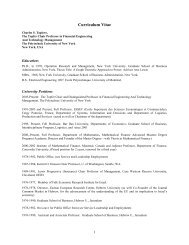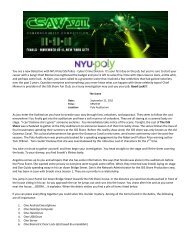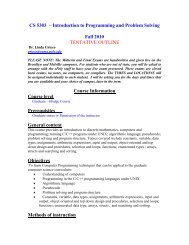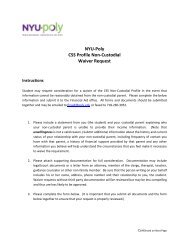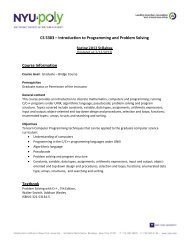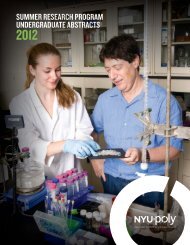Cable 2005 fall v1 - Polytechnic University
Cable 2005 fall v1 - Polytechnic University
Cable 2005 fall v1 - Polytechnic University
Create successful ePaper yourself
Turn your PDF publications into a flip-book with our unique Google optimized e-Paper software.
Erich Kunhardt’76EL unabashedly<br />
admits to being an inventor. But it is not<br />
a title he accepted easily. After learning<br />
Dennis Gabor, the Nobel laureate in physics,<br />
introduced himself that way, Kunhardt says,<br />
“I decided the term was indicative of my own<br />
multi-faceted personality and an apt description<br />
of my temperament.”<br />
Poly’s new provost and chief academic officer<br />
is crystal clear about his vision for the <strong>University</strong>—a<br />
vision that is closely aligned to that of<br />
the <strong>University</strong>’s President Jerry Hultin. “I want<br />
to create a distinctive community of higher<br />
learning that values and nurtures creativity—in<br />
particular inventiveness and innovation,” he<br />
says. “This community will offer students the<br />
exposure to the full cycle of technology.”<br />
That cycle, according to Kunhardt, is rooted<br />
in the genesis of technology in basic science and<br />
incorporates its engineering and implementation<br />
in society. “The presence and integration of<br />
these three areas into the learning environment,”<br />
he declares, “offers a very exciting arena<br />
for faculty and students.”<br />
Creativity, inventiveness and innovation were<br />
hallmarks of Kunhardt’s tenure as dean of the<br />
Arthur E. Imperatore School of Sciences and<br />
Arts and the George Meade Bond Professor of<br />
Physics at Stevens Institute of Technology.<br />
While at Stevens, he invented a technology for<br />
generating cool atmospheric pressure plasmas<br />
with a colleague, Dr. Kurt Becker, and founded<br />
the PlasmaSol Corporation, recently acquired<br />
by Stryker Instruments. True to his credo, he<br />
used the corporation as a laboratory so students<br />
would be exposed to the full cycle of technology.<br />
Kunhardt crafted the term “Technogenesis” to<br />
describe such an educational environment. He<br />
was named a finalist by Discovery Magazine’s<br />
Innovation Awards (2001) committee in the<br />
Environmental Category for the development of<br />
the technology used by PlasmaSol for environmental<br />
remediation.<br />
Born in the small town of Monte Cristi in the<br />
Dominican Republic, Kunhardt’s father was a<br />
physician who sparked his interest in science.<br />
After prep school in Connecticut, he moved to<br />
New York City—where he always wanted to<br />
live—and earned a bachelor’s and master’s from<br />
New York <strong>University</strong>. He subsequently entered<br />
Poly’s doctoral program in electrophysics. His<br />
fascination with this discipline was founded in<br />
his desire to explore and commingle what he<br />
calls his two extreme perspectives in scientific<br />
thought and creativity. Kunhardt explains.<br />
“I am an inventor…”<br />
“I have always tried to join two very divergent<br />
perspectives,” he says. “One is touching God or<br />
understanding the basic elements of nature and<br />
the other is touching humanity or how to make<br />
life comfortable for humans. The electrophysics<br />
program at Poly exemplified for me these two<br />
very different directions.”<br />
After earning his doctorate, Kunhardt joined<br />
Texas Tech <strong>University</strong> as a professor of electrical<br />
engineering and physics, and was awarded the<br />
Outstanding Faculty Teaching Award during his<br />
tenure at the school. In 1984, he joined the Poly<br />
faculty as a professor of electrophysics and physics<br />
and director of the Weber Research Institute. In<br />
1992, Kunhardt was awarded an honorary doctorate<br />
from the Russian Academy of Science,<br />
Institute of Electrophysics. He is also the recipient<br />
of numerous awards including the Thomas A.<br />
Edison Patent Award and the Halliburton Foundation<br />
Excellence in Research Award.<br />
“Poly is poised for greatness and I want<br />
to take part in making it happen.”<br />
Having come full circle, Kunhardt is thrilled<br />
to be working with an outstanding faculty in a<br />
small institution. “I was blown out of the water<br />
by the quality of the faculty Poly is attracting,”<br />
Kunhardt states. “Poly is poised for greatness<br />
and I want to take part in making it happen.”<br />
The <strong>University</strong>’s size is also a plus, according to<br />
the provost—the ideal setting for closer interaction<br />
among disciplines, a critical element for<br />
nurturing inventiveness.<br />
Kunhardt lives on the upper west side of<br />
Manhattan with his wife, Christine, who teaches<br />
children with learning disabilities, and is an avid<br />
pilot and scuba diver. As Kunhardt talks about<br />
his life outside of Poly, he inevitably returns to<br />
the themes that illuminate his drive and his<br />
strategic vision for the <strong>University</strong>: creativity,<br />
inventiveness and innovation.<br />
“The opportunity to educate students in an<br />
environment of inventiveness and teach them to<br />
think creatively is an exhilarating experience<br />
and a wonderful means of shaping Poly’s<br />
future,” states Kunhardt. “Such an approach to<br />
education will deftly position the <strong>University</strong> as a<br />
global leader in innovation.” ■<br />
Left: Provost Erich Kunhardt with<br />
students in an interdisciplinary<br />
laboratory.<br />
Below: Kunhardt chats with Net-<br />
Generation students during the<br />
Lynford Lecture.<br />
cable winter 2007 5




